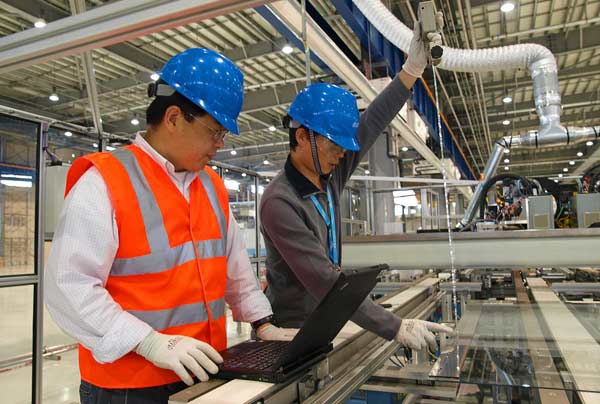Applied Materials Moves Solar Expertise to China
The world’s biggest supplier of solar-manufacturing equipment has opened a research and development center in China, and its chief technology officer will relocate from Silicon Valley to that country next month. Applied Materials, founded in 1967 as a semiconductor company, has manufactured in China for 25 years, but is expanding its presence to be closer to its customers and develop products suited to the country’s urban population.

“We’re doing R&D in China because they’re becoming a big market whose needs are different from those in the U.S.,” says Mark Pinto, Applied Materials’s CTO. Going forward, he says, “energy will become the biggest business for the company,” and China, not the U.S., “will be the biggest solar market in the world.”
Indeed, the move by Applied Materials is just the latest sign that China is rapidly moving to the forefront in adopting renewable energy technologies. China is no model for addressing climate change–its greenhouse-gas emissions are expected to nearly double by 2030. The lion’s share of demand for photovoltaics comes from Europe, which accounted for 82 percent of the photovoltaics sold in 2008, according to a report by Solarbuzz. China currently makes up less than 1 percent of the demand for photovoltaics, but its demand for photovoltaics is expected to grow; Beijing aims to produce 20,000 megawatts of solar energy by 2020.
One factor in the move by Applied Materials is that China offers manufacturing incentives that aren’t available for solar companies in the U.S. The tax credits in the federal stimulus package that passed in February were one of the first such incentives in a long time, says Pinto. But, he adds, “The location of factories of the kind we make isn’t driven by cost.” He lists the considerations that led to the company’s expansion in China: “Where does the product get consumed, what is the cost of shipping, and what incentives does the government offer?” At the research center in Xi’an, a large city home to many universities, Applied Materials will work with local customers and researchers to develop new products.
Applied Materials, the world’s largest maker of semiconductor- and display-manufacturing equipment, entered the solar market in 2006. In doing this, it built on its expertise in equipment for making large films of silicon, the material on which both display circuits and solar cells are based. By 2008, the company became the world’s largest photovoltaic-equipment supplier.

Its strategy, says Pinto, is to “help drive down costs through scaling.” The company developed equipment for building amorphous-silicon solar cells on thin glass panels the size of a garage door, 5.7 square meters. These sheets can then be sliced into smaller panels or left as they are. Working at this scale saves money; Applied Materials made it work by developing equipment that can coat the huge panels with uniform silicon films just nanometers thick.
To compete in both the U.S. and Chinese markets, says Ken Zweibel, director of the George Washington Solar Institute, the company will need to increase the efficiency of the solar cells that can be made using its equipment. “Amorphous silicon has a relatively low cost, but its efficiency is the lowest of all the thin-film solar cells,” says Zweibel. Cells made of cadmium telluride that are sold by U.S. thin-film company First Solar have an efficiency of around 11 percent. The amorphous-silicon solar cells made on Applied Materials’s equipment are at just over 8 percent. “The 3 percent difference in efficiency is a 30 percent difference in terms of overall cost,” Zweibel notes.
Pinto says research at the Xi’an center will focus on products suited to the way that country’s population is concentrated, in cities with tall buildings. “Cities in China don’t have very much rooftop” on which to place solar cells, says Pinto. The company plans to develop technologies such as electrochromic windows, which save heating and cooling costs by changing color with the weather. Solar cells embedded in windows might act both as a shade and an energy source. The company is also researching LED lighting and plans to work on thin-film batteries.
Keep Reading
Most Popular
Large language models can do jaw-dropping things. But nobody knows exactly why.
And that's a problem. Figuring it out is one of the biggest scientific puzzles of our time and a crucial step towards controlling more powerful future models.
The problem with plug-in hybrids? Their drivers.
Plug-in hybrids are often sold as a transition to EVs, but new data from Europe shows we’re still underestimating the emissions they produce.
Google DeepMind’s new generative model makes Super Mario–like games from scratch
Genie learns how to control games by watching hours and hours of video. It could help train next-gen robots too.
How scientists traced a mysterious covid case back to six toilets
When wastewater surveillance turns into a hunt for a single infected individual, the ethics get tricky.
Stay connected
Get the latest updates from
MIT Technology Review
Discover special offers, top stories, upcoming events, and more.